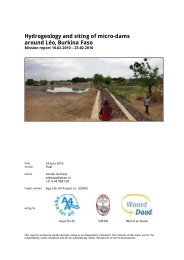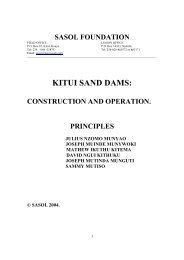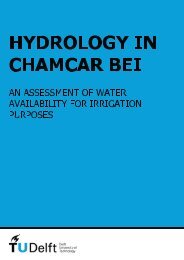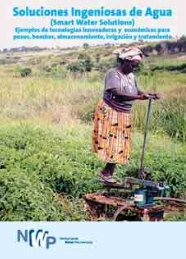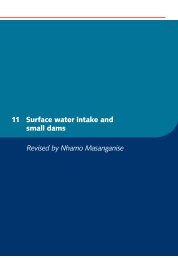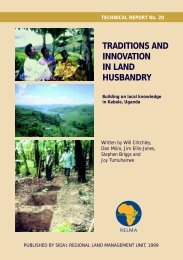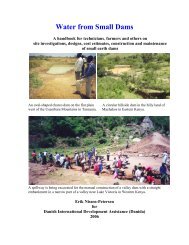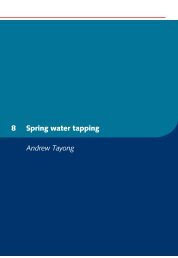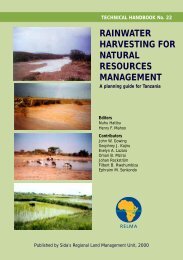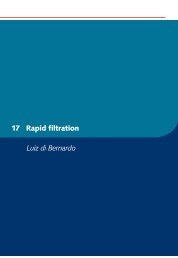Evaluation of the implementation of the solar still ... - SamSamWater
Evaluation of the implementation of the solar still ... - SamSamWater
Evaluation of the implementation of the solar still ... - SamSamWater
Create successful ePaper yourself
Turn your PDF publications into a flip-book with our unique Google optimized e-Paper software.
<strong>Evaluation</strong> <strong>of</strong> <strong>the</strong> <strong>implementation</strong> <strong>of</strong> <strong>the</strong> <strong>solar</strong> <strong>still</strong> principle onrun<strong>of</strong>f water reservoirs in Budunbuto, Somalia.Carolina S.E. Sardella, VU University, Faculty <strong>of</strong> Earth and Life Sciences, Department <strong>of</strong> Hydrologyand Geo-Environmental Sciences, De Boelelaan 1085 HV, Amsterdam, e-mail: csa800@student.vu.nlAbstractThe availability <strong>of</strong> fresh water resources and <strong>the</strong>ir quality is essential for poverty reduction in rural areas <strong>of</strong>numerous developing countries worldwide. This study focuses on <strong>the</strong> improvement <strong>of</strong> <strong>the</strong> water resources in <strong>the</strong>village <strong>of</strong> Budunbuto, in north-eastern Somalia. The objective is to evaluate <strong>the</strong> applicability <strong>of</strong> <strong>the</strong> <strong>solar</strong> <strong>still</strong>principle on surface water run<strong>of</strong>f reservoirs (so-called berkads), widely used in <strong>the</strong> study area. A <strong>solar</strong> <strong>still</strong>consist <strong>of</strong> an airtight basin, in which saline or contaminated water is evaporated and condensed on <strong>the</strong> top coverfor collection. The collected water has been purified during <strong>the</strong> process and can be used as drinking water. The<strong>implementation</strong> <strong>of</strong> <strong>solar</strong> <strong>still</strong>s is expected to improve both <strong>the</strong> water availability and quality as it minimizes <strong>the</strong>evaporation losses from <strong>the</strong> berkads and, at <strong>the</strong> same time, it purifies <strong>the</strong> water. Using <strong>the</strong> Penman open waterequation, it has been calculated that <strong>the</strong> daily evaporation loss from <strong>the</strong> berkads varies between 8 and 12 mm/dthroughout <strong>the</strong> year. This is on average about 1.4 m 3 /d per berkad. When implementing a <strong>solar</strong> <strong>still</strong> on a berkad,<strong>the</strong> output is estimated to vary between 100 and 590 litres <strong>of</strong> clean drinking water per day, depending on <strong>the</strong>efficiency <strong>of</strong> <strong>the</strong> system. Rain water harvesting on <strong>the</strong> top cover <strong>of</strong> <strong>the</strong> <strong>solar</strong> <strong>still</strong> would produce about 40 m 3 <strong>of</strong>water a year. This, in combination with <strong>the</strong> di<strong>still</strong>ate water, would suffice for <strong>the</strong> drinking water demand <strong>of</strong>Budunbuto when constructing between 3 and 11 berkads with <strong>solar</strong> <strong>still</strong>s. These results indicate that <strong>the</strong><strong>implementation</strong> <strong>of</strong> <strong>solar</strong> <strong>still</strong>s is a feasible measure for Budunbuto, even though <strong>the</strong>re are some uncertaintiesassociated with <strong>the</strong> results.Keywords: <strong>solar</strong> <strong>still</strong>, berkad, water purification, SomaliaIntroductionThe inadequate access to fresh water resources or <strong>the</strong> inappropriate quality <strong>of</strong> <strong>the</strong>se same resources is a commonproblem in developing countries and it forms <strong>the</strong> major constraint on poverty reduction in <strong>the</strong>se areas (FAO,2008). The current and predicted climate change will aggravate <strong>the</strong> water stress presently faced by severaldeveloping countries by imposing additional pressures on <strong>the</strong> availability and demand <strong>of</strong> water (Boko et al.,2007). Improving <strong>the</strong> availability <strong>of</strong> fresh water resources and its quality with simple technological innovationscan <strong>the</strong>refore contribute to a rapid enhancement in <strong>the</strong> livelihoods <strong>of</strong> <strong>the</strong> rural population in <strong>the</strong>se areas.This research focuses on <strong>the</strong> improvement <strong>of</strong> <strong>the</strong> water quantity and quality in <strong>the</strong> village Budunbuto, in <strong>the</strong>Nugaal region in Somalia (Figure 1). The major water source for <strong>the</strong> nomadic and settled pastoralist population<strong>of</strong> this area is surface water collected during <strong>the</strong> rainy season in artificial run<strong>of</strong>f catchments, which are known asberkads (see Research area). The current design <strong>of</strong> <strong>the</strong> berkads makes <strong>the</strong>m sensitive to pollution as organicmatter, animal faeces and garbage can easily end up in <strong>the</strong> water. Moreover, evaporation <strong>of</strong> water is estimated tobe a great loss.The objective <strong>of</strong> this study is to evaluate if <strong>the</strong> availability <strong>of</strong> clean fresh water could be improved through<strong>the</strong> <strong>implementation</strong> <strong>of</strong> a <strong>solar</strong> water purification system (i.e. a <strong>solar</strong> <strong>still</strong>) on <strong>the</strong> berkads. The analysis will startwith an estimation <strong>of</strong> <strong>the</strong> yearly water demand and consumption in Budunbuto. After this, <strong>the</strong> evaporation lossfrom <strong>the</strong> berkads will be calculated. The <strong>implementation</strong> <strong>of</strong> a <strong>solar</strong> <strong>still</strong> on <strong>the</strong> berkads is a solution to minimizethis evaporation loss and at <strong>the</strong> same time purify <strong>the</strong> water. Essential for <strong>the</strong> applicability <strong>of</strong> a <strong>solar</strong> <strong>still</strong> is toknow if <strong>the</strong> system will be capable <strong>of</strong> satisfying <strong>the</strong> water demand <strong>of</strong> <strong>the</strong> area. The output <strong>of</strong> <strong>the</strong> <strong>solar</strong> <strong>still</strong> will<strong>the</strong>refore be estimated using a <strong>the</strong>oretical approach. So far, little research has been done regarding <strong>the</strong> use a<strong>solar</strong> <strong>still</strong> for <strong>the</strong> purification <strong>of</strong> contaminated fresh water, and thus little is known about <strong>the</strong> quality <strong>of</strong> <strong>the</strong> waterproduced. This will be shortly discussed in order to establish if <strong>the</strong> output is <strong>of</strong> appropriate quality for humanconsumption.2
List <strong>of</strong> symbolsα Albedo for open water (0.06)A Aperture area <strong>of</strong> <strong>the</strong> <strong>still</strong> (m 2 )c p Specific heat <strong>of</strong> air at constant pressure (J kg -1 K -1 )γ Psychiometric constant (hPa K -1 )∆ Change <strong>of</strong> <strong>the</strong> saturation vapour pressure with temperature (hPa K -1 )e Water vapour pressure in air (hPa)e s Saturation vapour pressure (hPa)E Overall efficiency <strong>of</strong> <strong>the</strong> <strong>solar</strong> <strong>still</strong> (-)E a Aerodynamic component <strong>of</strong> <strong>the</strong> evaporation (W m -2 )E 0 Penman open water evaporation (W m -2 )G Daily global <strong>solar</strong> radiation (MJ m -2 )λ Latent heat <strong>of</strong> vapourization <strong>of</strong> water (J kg -1 )n Duration <strong>of</strong> bright sunshine (h)N Maximum possible sunshine duration (h)P Air pressure (hPa)Q Daily <strong>solar</strong> <strong>still</strong> output (l d -1 )R ln Net longwave radiation (W m -2 )R n Net radiation for an open water surface (W m -2 )R s ↓ Incoming short-wave <strong>solar</strong> radiation (W m -2 )σ Stefan-Boltzamann constant (5.670 · 10 -8 W m -2 K -4 )T Temperature (K)u Wind speed (m s -1 )Research areaThe village Budunbuto is located in <strong>the</strong> Nugaal region, a semi-desert area in north eastern Somalia (Figure 1).Somalia has an arid to semi-arid climate, where rainfall is <strong>the</strong> most determining characteristic with its greatspatial and temporal variability (Muchiri, 2007).Figure 1: Location <strong>of</strong> Budunbuto, Somalia.3
And where <strong>the</strong> net radiation for an open water surface (R n , in W m -2 ) is given by:R R ( 1 ) R(3)nWhere <strong>the</strong> net long-wave radiation (R ln , in W m -2 ) is calculated with (de Bruin and Kohsiek, 1981):slnRln4 T (0.53 0.67 e)(0.2 0.8n/ N)(4)The duration <strong>of</strong> <strong>the</strong> bright sunshine (n in h) has been derived from <strong>the</strong> following empirical relationship(Rietveld, 1978):R ( 0.24 0.5n/ N)(5)sR extThe psychometric constant (γ, in hPa K -1 ) is given by (Bringfelt, 1986):c p P (6)0.622And <strong>the</strong> aerodynamic component <strong>of</strong> <strong>the</strong> evaporation is given by (de Bruin and Kohsiek, 1981): E ( 3.7 4.0u)(e e)(7)Where <strong>the</strong> latent heat <strong>of</strong> vaporization <strong>of</strong> water (λ, in MJ m -2 ) was calculated with (Bringfelt, 1986):as 4185.5(751.78 0.5655T)(8)The data used for <strong>the</strong> calculations is shown in Table 2. The results indicate that <strong>the</strong> open water evaporation in<strong>the</strong> study area varies between 8 and 12 mm/d. The evaporation loss from one single berkad is calculated to be1.4 m 3 /d on average (Figure 4). This is a significant evaporation loss, which amounts to about 500 m 3 /year. Thisevaporated water from one berkad equals <strong>the</strong> yearly water demand <strong>of</strong> about 70 persons (~10% <strong>of</strong> Budunbuto‟spopulation). This result clearly evidences how a reduction in <strong>the</strong> evaporation loss would result in a significantincrease in <strong>the</strong> water availability in <strong>the</strong> area.Table 2: Input parameters for <strong>the</strong> Penman open water equation.MonthT*(C)RH***(%)Rs**(J/m2/d)Rext(J/m2/d)N(h)u**(m/s)z(m)P(Pa)Jan 23.3 58.6 22982400 32595696 11.73 5.1 470 95866Feb 24.0 56.3 23155200 35073457 11.73 4.5 470 95866Mar 25.7 56.8 25833600 37145163 11.95 4.0 470 95866Apr 27.6 62.7 23500800 37888029 12.19 3.3 470 95866May 28.6 58.0 21081600 37232316 12.39 3.9 470 95866June 28.4 45.5 24364800 36482490 12.49 6.9 470 95866July 27.9 43.1 24451200 36612305 12.45 7.9 470 95866Aug 27.9 44.0 23500800 37250299 12.28 6.7 470 95866Sep 28.4 49.7 26438400 37081618 12.04 5.4 470 95866Oct 26.8 60.3 24451200 35421366 11.81 3.3 470 95866Nov 24.7 59.0 23760000 33010488 11.60 3.7 470 95866Dec 23.7 61.0 23414400 31730188 11.51 4.7 470 95866* From FAO‟s Web LocClim, Local Monthly Climate Estimator** From NASA‟s Global Land Data Assimilation System (GLDAS)***From NASA‟s Surface meteorology and Solar Energy (SSE)6
Evaporation (m3/d)As expected <strong>the</strong> evaporation from <strong>the</strong> berkads has a similar pattern to that <strong>of</strong> <strong>the</strong> general evapotranspiration in<strong>the</strong> area. In both it is visible how <strong>the</strong> evaporation is <strong>the</strong> highest in <strong>the</strong> dry months, and it is exactly in thosemonths that <strong>the</strong> collected water in <strong>the</strong> berkads is needed <strong>the</strong> most. Preventing it from evaporating is a significantgain.3.0Average daily evaporation loss from berkads2.52.01.51.00.50.0Jan Feb Mar Apr May June July Aug Sep Oct NovMonthFigure 3. Daily evaporation loss from berkads (m 3 /d).Solar di<strong>still</strong>ation systemsSolar water di<strong>still</strong>ation is a simple, yet effective, technology that has long been used to provide potable water inmany remote areas <strong>of</strong> arid and semi-arid developing countries (Hanson et al., 2004 and Flendrig et al., 2009).The first known use <strong>of</strong> <strong>solar</strong> <strong>still</strong>s dates back to <strong>the</strong> 16 th century, when Arab alchemist used this system to distilwater on a small scale (Malik et al., 1982). The first large-scale <strong>solar</strong> <strong>still</strong> plant was build at <strong>the</strong> end <strong>of</strong> <strong>the</strong> 19 thcentury in Nor<strong>the</strong>rn Chile, where a 4460 m 2 basin was providing 22.5 m 3 d -1 <strong>of</strong> fresh water (Malik et al., 1982).After that <strong>the</strong> most significant step in <strong>the</strong> development <strong>of</strong> <strong>solar</strong> <strong>still</strong>s has been <strong>the</strong> design <strong>of</strong> a small scaleinflatable plastic <strong>still</strong> used by <strong>the</strong> United States armed forces after World War II (Malik et al., 1982 and Howeand Tliemat, 1977). Since <strong>the</strong>n, several <strong>solar</strong> di<strong>still</strong>ation systems have been developed, patents have beengranted and papers have been published (Kabeel and El-Agouz, 2011; Flendrig et al., 2009; Tiwari et al., 2003).The principleThe basic principle behind <strong>solar</strong> di<strong>still</strong>ation is simple and replicates <strong>the</strong> natural process <strong>of</strong> water purification(Badran, 2007). A <strong>solar</strong> <strong>still</strong> is an air tight basin that contains saline or contaminated water (i.e. feed water). It isenclosed by a transparent top cover, usually <strong>of</strong> glass or plastic, which allows incident <strong>solar</strong> radiation to passthrough. The inner surface <strong>of</strong> <strong>the</strong> basin is usually blackened to increase <strong>the</strong> efficiency <strong>of</strong> <strong>the</strong> system byabsorbing more <strong>of</strong> <strong>the</strong> incident <strong>solar</strong> radiation (Tiwari et al., 2003). The feed water heats up, <strong>the</strong>n starts toevaporate and subsequently condenses on <strong>the</strong> inside <strong>of</strong> <strong>the</strong> top cover, which is at a lower temperature as it is incontact with <strong>the</strong> ambient air. The condensed water (i.e. <strong>the</strong> di<strong>still</strong>ate) trickles down <strong>the</strong> cover and is collected inan interior trough and <strong>the</strong>n stored in a separate basin (Al-Hayek and Badran, 2004 and Tiwari et al., 2003). Thissystem is also known as passive <strong>solar</strong> <strong>still</strong>, as it operates solely on sun‟s radiation (Figure 4) (KalidasaMurugavel et al., 2008).From a radiative point <strong>of</strong> view <strong>the</strong> following happens inside <strong>the</strong> di<strong>still</strong>er unit: <strong>the</strong> part <strong>of</strong> <strong>the</strong> <strong>solar</strong> radiationthat is not reflected nor absorbed by <strong>the</strong> cover is transmitted inside <strong>the</strong> <strong>solar</strong> <strong>still</strong>, where it is fur<strong>the</strong>red reflectedand absorbed by <strong>the</strong> water mass (Tiwari and Singh, 2004). The amount <strong>of</strong> <strong>solar</strong> radiation that is absorbed is afunction <strong>of</strong> <strong>the</strong> absorptivity and depth <strong>of</strong> <strong>the</strong> water. The remaining energy eventually reaches <strong>the</strong> blackenedbasin liner, where it is mostly absorbed and converted into <strong>the</strong>rmal energy (Tiwari and Singh, 2004). Some <strong>of</strong>7
Even though well maintained <strong>still</strong>s working under optimized operating conditions can reach efficiencies up to50%, overall efficiencies <strong>of</strong> 30% are typical for single-basin <strong>solar</strong> <strong>still</strong>s (Kabeel and El-Agouz, 2011). Theefficiency <strong>of</strong> a <strong>solar</strong> <strong>still</strong> implemented on a berkad, is expected to be equal or lower than 30% because: Single basins with a water depth <strong>of</strong> 0.02 m resulted to have <strong>the</strong> highest annual yield (Kabeel and El-Agouz, 2011and Tiwari and Tiwari, 2007). The water depth in <strong>the</strong> berkads can be up to 3.5 m during<strong>the</strong> rainy seasons (when <strong>the</strong> berkads are fully filled), which is not optimal. However <strong>the</strong> di<strong>still</strong>ate output<strong>of</strong> a single basin <strong>solar</strong> <strong>still</strong> is inversely proportional to <strong>the</strong> water depth for basins with a depth up toabout 0.1 m. At greater depths, <strong>the</strong> yield becomes almost constant (Tiwari and Tiwari, 2007 and Kabeeland El-Agouz, 2011). The preferred material for <strong>the</strong> top cover is glass with a thickness <strong>of</strong> 3 mm (Kabeel and El-Agouz,2011). Glass has a higher <strong>solar</strong> transmittance and a longer lifetime compared to plastic, which isadvised to be used for <strong>the</strong> short-term use only (Kalidasa Murugavel et al., 2008). At <strong>the</strong> same time,glass is more expensive and fragile. For <strong>the</strong>se reasons it is assumed that <strong>the</strong> top cover will most likelybe <strong>of</strong> plastic (or plexiglass), thus reducing <strong>the</strong> efficiency <strong>of</strong> <strong>the</strong> system. It is expected that it will be hard to minimize side and bottom heat losses as no insulation material willbe used (since <strong>the</strong> <strong>solar</strong> <strong>still</strong>s will just be implemented above <strong>the</strong> already existing berkads). Vapourleakage is also expected to be difficult to minimize in this setting. All this reduces <strong>the</strong> efficiency <strong>of</strong> <strong>the</strong>system as energy that could be used for <strong>the</strong> evaporation <strong>of</strong> <strong>the</strong> water within <strong>the</strong> <strong>still</strong> will be lost.Based on <strong>the</strong> above assumption s it is possible to state at a high confidence level that that <strong>the</strong> overall efficiencywill be lower than 30%. With this <strong>the</strong>oretical approach it is however not possible to exactly define what <strong>the</strong>efficiency <strong>of</strong> <strong>the</strong> system will be and for this reason it has been chosen to calculate <strong>the</strong> output based on differentefficiencies (Table 3).Table 3: Estimated average output for one berkad with <strong>solar</strong> <strong>still</strong>, and number <strong>of</strong> berkads needed with <strong>solar</strong> <strong>still</strong>and rain water harvesting system.OutputOutput Output No. <strong>of</strong> berkads No. <strong>of</strong> personsEfficiency(l/m 2 )(l/d)(m 3 /yr)needed per berkad5% 0.5 100 35 11 7010% 1.0 195 70 7 10015% 1.5 295 110 6 13520% 2.0 390 140 5 16525% 2.5 490 180 4 20030% 3.0 590 215 3 230The estimated output varies between 100 and <strong>the</strong> 590 l/d on average. Even though <strong>the</strong> production rate per squaremeter can be relatively low (Table 3), it <strong>still</strong> is an economical way to provide clean drinking water in such aremote area. Moreover, it is important to notice that <strong>the</strong> di<strong>still</strong>ate produced is meant to be used solely for humanconsumption, implying that one berkad could satisfy <strong>the</strong> need <strong>of</strong> up to 230 persons (Table 3).Above this, rainwater harvesting on <strong>the</strong> top cover <strong>of</strong> <strong>the</strong> <strong>still</strong> could take place (Figure 5). This would increase<strong>the</strong> yearly clean water available with about 40 m 3 <strong>of</strong> water.As already said, <strong>the</strong> daily drinking water demand for Budunbuto is estimated to be 2.25 m 3 , which equals toabout 820 m 3 per year. This demand could be satisfied with 3 to 11 berkads with <strong>solar</strong> <strong>still</strong> and rain waterharvesting system (Table 3). This is a realistic result for Budunbuto.Assuming an efficiency <strong>of</strong> 15%, and thus a yearly output <strong>of</strong> 110 m 3 /yr plus 40 m 3 /yr <strong>of</strong> harvested rainwater,<strong>the</strong> drinking water tank should have a volume <strong>of</strong> 10 m 3 . This tank would satisfy <strong>the</strong> drinking water demand <strong>of</strong>130 people.9
l/dAverage monthly <strong>solar</strong> <strong>still</strong> output and rainwater harvesting (l/d)700Rainwater harvesting600Solar <strong>still</strong>5004003002001000Jan Feb Mar Apr May June July Aug Sep Oct Nov DecMonthFigure 5: Average rainwater harvesting (l/d) added to <strong>the</strong> daily output <strong>of</strong> a <strong>solar</strong> <strong>still</strong> with an efficiency <strong>of</strong> 15%Water qualityLittle research has been done regarding <strong>the</strong> water quality <strong>of</strong> <strong>the</strong> water produced by <strong>solar</strong>-<strong>still</strong>s based on pollutedor muddy water. However it is proven that nitrates, chlorides, iron, heavy metals and dissolved solids arecompletely removed by <strong>the</strong> <strong>solar</strong> <strong>still</strong> (Al-Hayek and Badran, 2004 and Zein and Al-Dallal, 1984). The processalso proved to be effective in <strong>the</strong> destruction <strong>of</strong> microbiological organisms present in <strong>the</strong> feed water (Al-Hayekand Badran, 2004). The di<strong>still</strong>ate is thus high purity water, which also lacks essential dissolved minerals.Drinking demineralised water can have serious health consequences, and it is thus <strong>of</strong> crucial importance that <strong>the</strong>essential minerals are added to <strong>the</strong> water before consumption (WHO, 2004b). The advised quantities <strong>of</strong> mineralswhere minimum or no adverse health effects are observed are shown are shown in Table 4.Table 4: Advised mineralogical quantities (from WHO, 2004b)Total DissolvedSolids (mg/l)Bicarbonateion (mg/l)Calcium(mg//l)Magnesium(mg/l)Hardness(mmol/l)Alkalinity(meq/l)Minimum 100 30 20 10Optimum 250-500 40-80 20-30 2-4Maximum 6.5It is however believed that no addition <strong>of</strong> minerals will be required in this case as <strong>the</strong> <strong>still</strong> di<strong>still</strong>ate will be storedin <strong>the</strong> same tank as <strong>the</strong> rain water will be, and also because <strong>the</strong> process will not be 100% clean. This will sufficeas a natural re-mineralization <strong>of</strong> <strong>the</strong> water. If <strong>the</strong> water seems to be too low on certain minerals, it is possible tore-mineralise it in an affordable and simple way by dissolution <strong>of</strong> natural occurring minerals (Hasson andBendrihem, 2006 and Ruggieri et al., 2008). Budunbuto is located in a limestone rich area. Running <strong>the</strong> di<strong>still</strong>atethrough a limestone bed can provide essential elements to <strong>the</strong> water (Hasson and Bendrihem, 2006 and Ruggieriet al., 2008). The process is as follows:CaCO3+ CO2+ H2O = Ca 2+ + 2HCO 3- (10)As a result <strong>the</strong> calcium, hardness and alkalinity concentrations are increased (Hasson and Bendrihem, 2006 andRuggieri et al., 2008). Remineralisation rates can differ significantly based on <strong>the</strong> chemical and mineralogicalcomposition and texture <strong>of</strong> <strong>the</strong> limestone used (Ruggieri et al., 2008). According to <strong>the</strong> European Norm EN1018:1998, which assess <strong>the</strong> composition <strong>of</strong> limestone used for water treatment, <strong>the</strong> limestone should contain>85% <strong>of</strong> calcite.10
Practical applicationWhen implementing a <strong>solar</strong> <strong>still</strong> system on <strong>the</strong> berkads it is essential that <strong>the</strong> design is as simple as possible but<strong>still</strong> effective. Keeping in mind <strong>the</strong> economic and logistic aspects, affordable and local materials should be usedwhenever possible. Never<strong>the</strong>less, to guarantee a good functioning <strong>of</strong> <strong>the</strong> system, some parts need to beimported.For Budunbuto, a single slope <strong>solar</strong> <strong>still</strong> is preferred above a double slope <strong>solar</strong> <strong>still</strong>, as having only one slopeequals to having only one internal gutter which can be easily connected to <strong>the</strong> drink water storage tank. Toincrease <strong>the</strong> <strong>solar</strong> interception, <strong>the</strong> <strong>solar</strong> <strong>still</strong> needs an equator facing top cover, with <strong>the</strong> length <strong>the</strong>refore linedon an east-west axis (this might be problematic for already existing berkads, which might not be orientatedproperly). The top cover should be set at an angle <strong>of</strong> 10º, which is considered to be <strong>the</strong> most accepted angle for asingle slope <strong>solar</strong> <strong>still</strong> at this latitude (Khalifa, 2010). It should be made ei<strong>the</strong>r out <strong>of</strong> a 3-4 mm thick glass or aultra-violet resistant polyvinyl chloride (PVC) sheet. As mentioned above, glass is <strong>the</strong> preferred material as itincreases <strong>the</strong> efficiency <strong>of</strong> <strong>the</strong> <strong>solar</strong> <strong>still</strong>. When choosing for a glass cover, it is important that <strong>the</strong> structure <strong>of</strong> <strong>the</strong><strong>still</strong> is build to carry <strong>the</strong> weight <strong>of</strong> <strong>the</strong> relatively heavy glass. The sides <strong>of</strong> <strong>the</strong> <strong>still</strong> should be closed in order tomake <strong>the</strong> <strong>still</strong> airtight. This could be done by using <strong>the</strong> same material chosen for <strong>the</strong> top cover. At <strong>the</strong> inlet <strong>of</strong> <strong>the</strong>surface run<strong>of</strong>f water, a one way door should be placed (Figure 6). This would allow <strong>the</strong> surface run<strong>of</strong>f water t<strong>of</strong>low into <strong>the</strong> berkad during periods <strong>of</strong> rainfall, as <strong>the</strong> door would <strong>the</strong>n open under <strong>the</strong> weight <strong>of</strong> <strong>the</strong> water, but itwould remain shut during dry periods.The condensed water should be collected in a gutter fixed along <strong>the</strong> lower edge <strong>of</strong> <strong>the</strong> cover. On <strong>the</strong> outerside <strong>of</strong> <strong>the</strong> cover a similar gutter should be placed for <strong>the</strong> collection <strong>of</strong> <strong>the</strong> rainwater. Both gutters should beplaced on a small angle to let <strong>the</strong> water run towards <strong>the</strong> airtight pipes that connect it to <strong>the</strong> drinking water tank.Both gutters should also be made <strong>of</strong> a material that is not affecting <strong>the</strong> properties <strong>of</strong> <strong>the</strong> water and so should <strong>the</strong>airtight pipes be. Particular attention needs to be used when installing <strong>the</strong> rain water collection gutter, as factorsas <strong>the</strong> weight <strong>of</strong> <strong>the</strong> water in <strong>the</strong> gutter and <strong>the</strong> wind effects should be considered. It is also advised to add agutter screen (e.g. a simple mesh with a fine pattern), as debris from <strong>the</strong> ro<strong>of</strong> may collect in <strong>the</strong> gutter,obstructing it.The clean water storage tank should be placed in <strong>the</strong> immediate vicinity <strong>of</strong> <strong>the</strong> berkad and should be properlyclosed, preventing any light from entering. It is advised to place <strong>the</strong> drinking water tank in <strong>the</strong> ground (lowerthan <strong>the</strong> gutters), as in this way <strong>the</strong> water would flow under gravity towards <strong>the</strong> tank.A hand pump should be used for <strong>the</strong> extraction <strong>of</strong> <strong>the</strong> drinking water from <strong>the</strong> tank, which should solely be usedfor human consumption. Ano<strong>the</strong>r hand pump should be used for <strong>the</strong> extraction <strong>of</strong> <strong>the</strong> water from <strong>the</strong> berkad,which should be used for animal watering and o<strong>the</strong>r domestic use (washing, cooking, etc.).Very important in <strong>the</strong> design <strong>of</strong> <strong>the</strong> system is that all <strong>the</strong> joints and fittings are accurately isolated to preven<strong>the</strong>at loss. For this reason, a one way valve could be placed at connection point <strong>of</strong> <strong>the</strong> internal gutter and <strong>the</strong> pipethat goes to <strong>the</strong> drinking water tank.This type <strong>of</strong> <strong>solar</strong> <strong>still</strong> systems requires little maintenance; however <strong>the</strong> following aspects should regularly bechecked:- The fittings and joints, in order to prevent colder air flow from outside into <strong>the</strong> <strong>solar</strong> <strong>still</strong>.- The top cover, which should be checked for cracks and scratches which may reduce <strong>the</strong> <strong>solar</strong>transmittance. When using a PVC cover, it should be replaced after about 2 to 4 years.- The waste product that is left over in <strong>the</strong> berkad at <strong>the</strong> end <strong>of</strong> <strong>the</strong> dry season should periodically beremoved. It should be disposed outside <strong>of</strong> <strong>the</strong> catchment area <strong>of</strong> <strong>the</strong> berkads, to prevent it from reentering<strong>the</strong> system.The above described advisable design for <strong>the</strong> <strong>solar</strong> <strong>still</strong>s in Budunbuto is very simple and (thus) not optimallyefficient. It has been chosen to keep <strong>the</strong> design simple because an increase in <strong>the</strong> efficiency and productivity <strong>of</strong><strong>the</strong> <strong>still</strong> is usually coupled to an increase in cost, which is an undesirable result. With this design, <strong>the</strong> <strong>solar</strong> <strong>still</strong>srepresent a low cost technology with low cost maintenance, which can be carried out by unskilled manpower(Tiwari et al., 2003).11
Figure 6: Simplification <strong>of</strong> a <strong>solar</strong> <strong>still</strong> on a berkadDiscussion and recommendationsThe results presented above indicate that <strong>the</strong> <strong>implementation</strong> <strong>of</strong> a <strong>solar</strong> <strong>still</strong> on (already existing and new)berkads is a feasible measure for <strong>the</strong> improvement <strong>of</strong> <strong>the</strong> water quantity and quality in <strong>the</strong> village Budunbuto.Above this, it is generally agreed that <strong>solar</strong> <strong>still</strong>s are a good option in remote areas where <strong>the</strong> water demand doesnot exceed <strong>the</strong> 200 m 3 /day (Tiwari et al., 2003 and Fath, 1998). However, <strong>the</strong> approach used is very <strong>the</strong>oreticaland abstract, what inevitably may have lead to some inaccuracies:- The evaporation loss has been calculated based mostly on remotely sensed data, which is availableonly at a large scale for <strong>the</strong> studied location. This is a source <strong>of</strong> inaccuracy within <strong>the</strong> results <strong>of</strong> <strong>the</strong>Penman open water evaporation equation. However, it is important to notice that due to <strong>the</strong> availability<strong>of</strong> this data it is actually possible to make estimates over an o<strong>the</strong>rwise data scarce region.- The actual water consumption rate, and thus <strong>the</strong> amount <strong>of</strong> berkads needed with a <strong>solar</strong> <strong>still</strong> system,might differ from what has been estimated. This because <strong>the</strong> water consumption rates and <strong>the</strong> number<strong>of</strong> inhabitants <strong>of</strong> Budunbuto are also an estimation based on <strong>the</strong> little information that is available.- The <strong>the</strong>oretical approach used to estimate <strong>the</strong> output from <strong>the</strong> <strong>solar</strong> <strong>still</strong> is very abstract and might beinaccurate. On <strong>the</strong> o<strong>the</strong>r hand, this seems <strong>the</strong> most reasonable approach to use when estimating <strong>solar</strong><strong>still</strong> output <strong>the</strong>oretically, as it is possible to make assumptions for <strong>the</strong> efficiency <strong>of</strong> <strong>the</strong> system and <strong>the</strong>remaining parameters are all known.- The <strong>solar</strong> <strong>still</strong> design as described above resulted to be <strong>the</strong> most suitable for Budunbuto. However, as<strong>the</strong> approach used is very <strong>the</strong>oretical, it may not be <strong>the</strong> most functional design in practice. Therefore itis recommended to test various simple <strong>solar</strong> <strong>still</strong> designs during <strong>the</strong> pilot project. This could be done byconstructing both single and double slope <strong>solar</strong> <strong>still</strong>s, using plastic and glass top covers.Although <strong>the</strong> above described inaccuracies are present, <strong>the</strong> information <strong>of</strong> this report will provide a reliableguideline for <strong>the</strong> pilot project, during which <strong>the</strong> working <strong>of</strong> <strong>the</strong> system will be tested. It is expected that <strong>the</strong>actual production rate <strong>of</strong> <strong>the</strong> <strong>solar</strong> <strong>still</strong> will be within <strong>the</strong> range estimated and that <strong>the</strong> efficiency will most likelybe around 15%. However, to satisfy <strong>the</strong> water demand for animal watering and domestic use (about 35.5 m 3 /yr),more berkads are needed. These berkads obviously do not need a <strong>solar</strong> <strong>still</strong> system, as <strong>the</strong> water does not need tobe within <strong>the</strong> mineralogical and bacteriological standard used for drinking water.During <strong>the</strong> pilot phase <strong>of</strong> <strong>the</strong> project, it is advised to accurately measure both <strong>the</strong> quantity and quality <strong>of</strong> <strong>the</strong>water produced by <strong>the</strong> <strong>still</strong>. The electrical conductivity, pH, NO 3-and <strong>the</strong> alkalinity <strong>of</strong> <strong>the</strong> water should directlybe measured in <strong>the</strong> field. For <strong>the</strong> analysis <strong>of</strong> <strong>the</strong> major cations and anions, it is advised to take 10 ml samples12
filtered with a 0.45 μm membrane filter, which should <strong>the</strong>n be sent to a water laboratory. Also <strong>the</strong>bacteriological content <strong>of</strong> <strong>the</strong> water should be analysed, to make sure that <strong>the</strong> bacteria and viruses are actuallynot present in <strong>the</strong> drinking water. These measurements would certainly contribute to increase <strong>the</strong> knowledgeregarding <strong>the</strong> purification <strong>of</strong> contaminated water by using <strong>solar</strong> <strong>still</strong>s.Once <strong>the</strong> working <strong>of</strong> <strong>the</strong> system has proven to be effective, it is important that <strong>the</strong> water users are well informedabout <strong>the</strong> <strong>solar</strong> <strong>still</strong> in order to ensure its correct functioning and its sustainability. It is essential to emphasizethat <strong>the</strong> <strong>solar</strong> <strong>still</strong> will only produce <strong>the</strong> expected output when it is fully airtight. This means that <strong>the</strong> water inletshould never be opened by <strong>the</strong> users to extract <strong>the</strong> water from <strong>the</strong> berkads as <strong>the</strong> hand pumps should solely beused for that. The same holds for <strong>the</strong> drinking water tank which should also never be opened. Ano<strong>the</strong>r importantpoint is that <strong>the</strong> maintenance <strong>of</strong> <strong>the</strong> berkads is regularly carried out and that possible leaks are immediatelydetected and repaired. Particular attention should be paid for <strong>the</strong> drinking water tank, which is positioned in <strong>the</strong>ground, what makes it difficult to detect possible leaks.ConclusionsEven though <strong>the</strong>re are uncertainties associated with <strong>the</strong> <strong>the</strong>oretical and abstract approach used in this research,<strong>the</strong> results indicate that <strong>the</strong> <strong>implementation</strong> <strong>of</strong> a <strong>solar</strong> <strong>still</strong> on berkads can be a feasible measure to reduceevaporation loss and to improve <strong>the</strong> drinking water quality in Budunbuto.The production rate <strong>of</strong> di<strong>still</strong>ate water is estimated to be between 100 and 590 l/d per berkad depending on<strong>the</strong> efficiency <strong>of</strong> <strong>the</strong> system. Above this, rain water harvesting on <strong>the</strong> top cover <strong>of</strong> <strong>the</strong> <strong>still</strong> can contribute toincrease <strong>the</strong> water available with about 40 m 3 a year. This implies that Budunbuto would need between 3 and 11berkads to fully satisfy <strong>the</strong> drinking water demand <strong>of</strong> <strong>the</strong> village, which is a very realistic result. However, moreberkads (without <strong>solar</strong> <strong>still</strong>) are needed to satisfy <strong>the</strong> remaining water demand for animal watering and domesticuse (about 35.5 m 3 /yr).The water extracted from <strong>the</strong> drinking water tank is expected to be within <strong>the</strong> bacteriological andmineralogical advised quantities where no adverse health effects are observed. The di<strong>still</strong>ate is expected to bepartially re-mineralized during <strong>the</strong> mixing process with <strong>the</strong> harvested rain water. However, accurate monitoringand analysis <strong>of</strong> <strong>the</strong> water quality is advised during <strong>the</strong> pilot project.Based on <strong>the</strong> available information and based on <strong>the</strong> estimates made, <strong>the</strong> recommended design for <strong>the</strong> <strong>still</strong> isa single slope <strong>solar</strong> <strong>still</strong>, with an equator facing top cover placed at a 10º angle. The top cover should(preferably) be a glass top cover. Assuming an efficiency <strong>of</strong> 15% for <strong>the</strong> <strong>solar</strong> <strong>still</strong>, <strong>the</strong> drinking water tankshould have a capacity <strong>of</strong> 10 m 3 .To conclude, <strong>the</strong> <strong>implementation</strong> <strong>of</strong> a <strong>solar</strong> <strong>still</strong> on (existing) berkads seems to be a good option inBudunbuto, as with a low cost technology with low cost maintenance, it is possible to improve <strong>the</strong> quantity andquality <strong>of</strong> <strong>the</strong> available water.ReferencesAbbate et al.. (1994) Geological map <strong>of</strong> Somalia, scale 1:1,500,000. Florence, ItalyAl-Hayek, I. and Badran, O.O. (2004) The effect <strong>of</strong> using different designs <strong>of</strong> <strong>solar</strong> <strong>still</strong>s on water di<strong>still</strong>ation.Elsevier: Desalination 169:121-127.Badran, O.O. and Abu-Khader, M.M. (2007) Evaluating <strong>the</strong>rmal performance <strong>of</strong> a single slope <strong>solar</strong> <strong>still</strong>. HeatMass transfer 43:985-995.Banks, D. (2008) Potable water strategies Mudung, Somalia, with special reference to <strong>the</strong> local economics <strong>of</strong>motorised borehole systems for watering nomadic livestock. Hydrogeology Journal 16:765-777Brich, I. (2008) Somaliland/Somali region desk review. Securing pastoralism in East and West Africa:protecting and promoting livestock mobility.Boko, M., Niang, I., Nyong, A., Vogel, C., Gi<strong>the</strong>ko, A., Medany, M., Osman-Elasha, B., Tabo, R. and Yanda P.(2007) Africa. Climate Change 2007: Impacts, Adaptation and Vulnerability. Contribution <strong>of</strong> Working13
Group II to <strong>the</strong> Fourth Assessment Report <strong>of</strong> <strong>the</strong> Intergovernmental Panel on Climate Change, M.L. Parry,O.F. Canziani, J.P. Palutik<strong>of</strong>, P.J. van der Linden and C.E. Hanson, Eds., Cambridge University Press,Cambridge UK, 433-467.Bringfelt, J. (1986) Test <strong>of</strong> a forest evapotranspiration model. Meteorology and Climatology Reports 52, SMHI,Norrköpping, Sweden.de Bruin, H.A.R. and Kohsiek, W. (1981) Toepassingen van de Penman formule. Wetenschappelijk RapportWR 79-3, Koninklijk Nederlands Meteorologisch Instituut (KNMI), De Bilt, The Ne<strong>the</strong>rlands.EC Somalia Unit (2004) Project development: rural water and sanitation interventions in nor<strong>the</strong>ast and sou<strong>the</strong>rnSomalia, Vol II. Preliminary Assessment and Strategic Approaches Report. Prepared by MWH and aconsortium led by Parsons Brinckerh<strong>of</strong>f for <strong>the</strong> European Commission Somalia Unit (Nairobi) Frameworkcontract AMS/451–Lot No. 2, Request for Services No 2003/69844–Version 2, 24 February 2004, EuropeanCommission, Brussels.FAO (2008) Water and <strong>the</strong> rural poor. Interventions for improving livelihoods in sub-Saharan Africa. Food andAgriculture Organisation <strong>of</strong> <strong>the</strong> United Nations, Rome.Fath, H.E.S. (1998) Solar di<strong>still</strong>ation: a promising alternative for water provision with free energy, simpletechnology and clean environment. Elsevier: Desalination 166:45-56.Flendrig, L.M., Shah, B., Subrahmaniam, N. and Ramakrishnan, V. (2009) Low cost <strong>the</strong>rm<strong>of</strong>ormed <strong>solar</strong> <strong>still</strong>water purifier for D&E countries. Elsevier: physics ans Chemistry <strong>of</strong> <strong>the</strong> Earth 34:50-54.Garg, H.P. and Mann, H.S. (1976) Effect <strong>of</strong> climatic, operational, and design parameters on <strong>the</strong> year roundperformance <strong>of</strong> single-sloped and double-sloped <strong>solar</strong> <strong>still</strong> under Indian arid zone conditions. Journal <strong>of</strong>Solar Energy18:159.Hanson, A, Zachritz, W., Stevens, K., Mimbela, L., Polka, R. and Cisneros, L. (2004) Di<strong>still</strong>ate water quality <strong>of</strong>a single-basin <strong>solar</strong> <strong>still</strong>: laboratory and field studies. Elsevier: Solar Energy 76:635-645.Hasson, D. And Bendrihem, O. (2006) Modeling remineralization <strong>of</strong> desalined water by limestone dissolution.Elsevier: Desalination 190:189-200.Howe, E.D. and Tliemat, B.W. (1977) Fundamentals <strong>of</strong> water desalination. Solar Engineering. 431-464.Kabeel, A.E. and El-Agouz, S.A. (2011) Review <strong>of</strong> researches and developments on <strong>solar</strong> <strong>still</strong>s. Elsevier:Desalination 276:1-12.Kalidasa Murugavel, K., Chockalingam, Kn.K.S.K. and Srithar, K. (2008) Progress in improving <strong>the</strong>effectiveness <strong>of</strong> <strong>the</strong> single basin passive <strong>solar</strong> <strong>still</strong>. Elsevier: Desalination 220:667-686.Khalifa, A.J.N. (2010) On <strong>the</strong> effect <strong>of</strong> cover tilt angle <strong>of</strong> <strong>the</strong> simple <strong>solar</strong> <strong>still</strong> on its productivity in differentseasons and latitudes. Energy Conversion and Management 52:431-436.Malik, M.A.S, Tiwari, G.N., Kumar, A. and Sodha, M.S. (1982) Solar di<strong>still</strong>ation. Pergamon press Ltd, UnitedKingdom.Muchiri, P.W. (2007) Climate <strong>of</strong> Somalia. Technical Report No W-01, FAO-SWALIM, Nairobi, Kenya.Ocean Training & Promotion / Cabdulahi Aid Service (2005) Project proposal water for Heema – A start <strong>of</strong> asustainable development for Heema, Puntland, Somalia. Alphen aan de Rijn, The Ne<strong>the</strong>rlands.Practical Action. Solar Di<strong>still</strong>ation – Technical Brief.Rietveld, M.R. (1978) A new method for estimating <strong>the</strong> regression coefficients in <strong>the</strong> formula relating <strong>solar</strong>radiation to sunshine. Agricultural Meteorology 19:243-252.Ruggieri, F., Fernadnez-Turiel, J.L., Gimeno, D., Valer, F., García, J.C. and Medina, M.E. (2008) Limestoneselection criteria for EDR water remineralisation. Elsevier: Desalination 227:314-326.<strong>SamSamWater</strong> (2010) Rainwater harvesting and shallow groundwater solutions in Budunbuto, Somalia.SWALIM (2009) Inventory <strong>of</strong> Drainage Basins <strong>of</strong> Nor<strong>the</strong>rn Somalia. Technical Report. Nairobi, Kenya.Tiwari, A.K. and Tiwari, G.N. (2007) Thermal modeling based on <strong>solar</strong> fraction and experimental study <strong>of</strong> <strong>the</strong>annual and seasonal performance <strong>of</strong> a single-basin <strong>solar</strong> <strong>still</strong>: <strong>the</strong> effect <strong>of</strong> water depths. Desalination207:184-204.Tiwari, G.N. and Singh, H.N. (2004) Solar di<strong>still</strong>ation. Solar Energy Conversion and Photoenergy Systems Vol.II.Tiwari, G.N., Singh, H.N. and Tripathi, R. (2003) Present status <strong>of</strong> <strong>solar</strong> di<strong>still</strong>ation. Elsevier: Solar Energy75:367-373.WHO (2003) Domestic water quantity, service level and health. Geneva, Switzerland .14
WHO (2004a) Water requirements, impinging factors, and recommended intakes. Geneva, Switzerland.WHO (2004b) Health risks from drinking demineralised water. Geneva, Switzerland.WMO (2008) Guide to meteorological instruments and methods <strong>of</strong> observation. WMO Report 8, WorldMeteorological Organization, Geneva, Switzerland. Seventh edition.Zein, M. and Al-Dallal (1984) Solar desalination correlation with meteorological parameters. In: 2 nd ArabInternational conference, p.288.15



